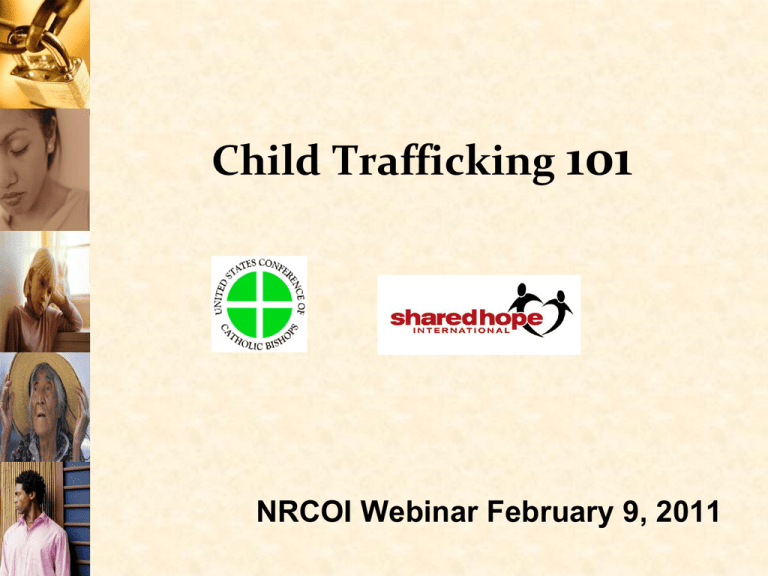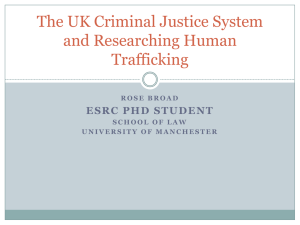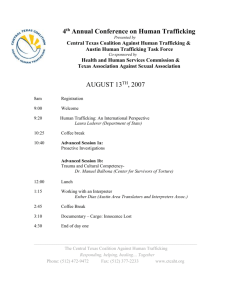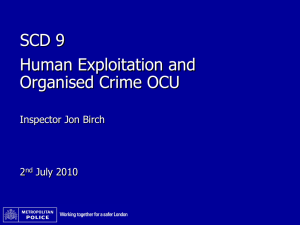
Child Trafficking 101
NRCOI Webinar February 9, 2011
US Conference of Catholic Bishops, AntiTrafficking Services: 1-866-504-9966
Shared Hope International: 1-866-HERLIFE
Training Outline
Introductions
Child trafficking – definition, scope, nature
Intersection with child welfare
Overview of victim and trafficker profiles
Victim identification
Combating trafficking in the US
National and local resources
What is Human Trafficking?
Modern day form of slavery
Human rights violation
The ultimate exploitation
A federal and state (some places) crime in the U.S.
Followed by drugs and arms, the fastest growing
source of profit
Trafficking Victims Protection
Act (TVPA)
Defines “Severe Forms” of Trafficking as:
sex trafficking in which a commercial sex act is
induced by force, fraud, or coercion, or in which
the person induced to perform such an act has
not attained 18 years of age; or
the recruitment, harboring, transportation,
provision, or obtaining of a person for labor or
services, through the use of force, fraud, or
coercion for the purposes of subjection to
involuntary servitude, peonage, debt bondage,
or slavery.
Common trafficking types
Sex trafficking
Prostitution
Street prostitution
Brothels
Residential homes
Massage Parlors
Spas
Strip Clubs
Pornography
Sex Tourism
Labor trafficking
Agricultural Work
Domestic Service
Sweatshops/factories
Hotel housekeeping
Construction
Restaurant Work
Nail Salons
Peddling
Informal labor sectors
Simply
Those under 18 involved in commercial sex
Those 18 or over involved in commercial sex
through force, fraud, or coercion
Those forced to perform labor and/or services in
involuntary servitude, peonage, debt bondage or
slavery through force, fraud, or coercion
Process (what)
Recruiting,
harboring,
transportation,
obtaining or
provision of persons
Means (how)
Force
Fraud
Coercion
End (why)
Forced labor/services: Involuntary servitude,
debt bondage, peonage, or slavery
Commercial sex act (with minors, no force,
fraud, coercion required)
Smuggling vs. Trafficking
SMUGGLING
• Typically consensual
• Crime against a country
• Movement across an international
border
• Fee for service
• Relationship ends when smuggling
is completed
TRAFFICKING
• Not consensual
• Crime against a person
• No movement required
• Does not require payment
• Relationship with
trafficker/smuggler is ongoing
Key Statistics
12.3 million children and adults are victims of
human trafficking (The 2010 U.S. Department of
State Trafficking in Persons Report).
1.2 million children under the age of 18 are
estimated to be victims (The International
Labour Organization and United Nation’s
Children's Fund).
More than 244, 000 children in the United States
are estimated to be at risk of commercial sexual
exploitation each year (Estes and Weiner, 2001)
Intersection with child welfare
Children are exploited and abused by
traffickers (in and out of their home)
Many child trafficking victims have at some
point been in contact with or in the care of
the child welfare system
Many have history of abuse, running away,
are homeless or throwaways
Victims lack the protection of family or have
no family to protect them
Traffickers are Diverse
Organized criminal groups
Family members
Business owners
Labor contractors
Recruiting companies
Neighbors, friends, family members,
boyfriends, acquaintances
Government officials
Recruitment tactics used by
traffickers
False promises of…
A good job
A better life
Love
Marriage
An opportunity to provide for their
family
Educational opportunities
Traffickers methods and tactics
Recruitment methods
Word of mouth
Newspaper ads
Internet
Fake employment
agencies
Family or
acquaintances
Force (abduction)
Control tactics
Physical and sexual
abuse
Threats against victim
and or victim’s family
Garnish income/wages
Restrict contact with
outside world
Seize or destroy travel
documents
Victims are Varied
Children, women and men
Individuals, families or groups
Educated or illiterate
U.S. citizen or foreign born
Documented or undocumented
Diverse in age, race, class, gender, religion
and culture with multiple needs
Recent cases in the news
A mother in Florida accused of child
trafficking and abuse. The mother allegedly
forced her 4 daughters, ages 9 to 15, to buy
prescription drugs and beat them with cords
and hangers. The oldest told officials she was
forced to prostitute herself to earn drug
money for the mother.
Source: News Press
Recent cases in the news
A North Carolina woman was indicated on charges of
forcing an undocumented teenager into slavery. She
was charged with forced labor and document
servitude. She is accused of forcing the teen to sell
goods including alcohol; starvation and making him
clean her yard and sleep on the floor of her mobile
home. If convicted, she faces 20 years in prison and
fine of up to $500, 000.
Source: Charlotte Observer
Victim Identification
Child Trafficking Indicators
Compiled from the work of USCCB through the Anti-Trafficking Services Program and the
United Nations Office of Drugs and Crime:
Evidence of sexual,
physical, mental or
emotional abuse
Engagement in work
unsuitable for children
Identification/documents
confiscated by employer or
someone else
No access to family
members or friends
Not in school or significant
gaps in schooling
Work long hours, have no
access to their wages or
have few if any time off
Living in workplace or
with employer
Have tattoos or other
marks indicating
ownership by their
exploiter –“branding”
Owing large sum of money
Appear unusually fearful
or anxious for themselves
or family members
Who may encounter victims
Social service agencies including child
welfare
Runaway, throwaway and homeless
shelters
Federal, state and local law enforcement
officers
Medical personnel
Community organizations
Neighbors
General Challenges to
Identification
Hidden nature of the crime
Lack of understanding and awareness about
human trafficking
Perception that victims are criminals
Trafficking victims rarely self-identify
If arrested, trafficking victims may not
disclose their situation out of fear/trauma
Some are mistakenly identified as adults
Domestic Minor Sex Trafficking
Federal law relating to child
sex trafficking
◦ Any youth under the age of 18 involved in a
commercial sex act = trafficking victim
◦ “Commercial” means anything of value
given to or received by any person in
exchange for a sex act (money, food, shelter)
◦ Victims should not be held responsible for
crimes committed during the course of
their exploitation
The National Report on
Domestic Minor Sex Trafficking
Shared Hope International received a grant from the
Department of Justice to assess Domestic Minor Sex Trafficking
in eleven areas in the United States, which culminated in the
National Report, released in July 2009.
The findings:
At least 100,000 children are used in prostitution every
year in the United States (NCMEC)
The average age of entry into prostitution is 13 years
old
American children are easy targets
Who are the Victims?
Homeless
and/or runaway youth
As many as 2.8 million children live on the streets
Youth
with history of abuse
Youth with low self esteem, depression
Youth with one parent in jail
Age is the greatest vulnerability factor
Label determines access to services
Juvenile Delinquent
run away
child trafficking victim
Ho
promiscuous
homeless
Child Prostitute
victim
child sexual abuse
Prostitute
Commercially sexually exploited child
Who are the Traffickers?
Trafficker = Pimp
Anyone exerting control over a minor, even a peer
(Boyfriend, father, mother, brother, uncle, coach, teacher)
Men or women; any age or race
Street pimp to organized crime
Anyone who benefits from or facilitates the commercial
sexual exploitation of a minor
Pimp Control: Creating the
Trauma Bond
Calculated
targeting and recruitment
Learn
and exploit the child’s specific
vulnerabilities
Break
Use
down personal agency and autonomy
physical and psychological torture
Couple
attachment to authority figure with fear,
punishment, and abandonment
Captor becomes savior
DMST Power & Control
Wheel*
Coercion and Threats
Threatening family members
and friends
Making her do illegal acts
Harming another girl for
victim’s disobedience
Isolation
Emotional Violence
Isolating victim from social
supports
Unfamiliar or unaware of
geographic location
Sever ties with all family and
friends
Cycles of affection followed by
violence
Forbidden interaction with any
person outside of prostitution
life
Shaming and humiliating
Power
and
Control
Economic
Dependence
Refusing to allow victim to go
to school
Physical Violence
Torture/constant threat of
death
Branding/tattooing
Taking all money and
property from a victim
Locking victim in small
spaces
Refusing to allow victim to be
employed
Starvation
Forced drug use
Sexual Violence
Manipulation
Exploiting a victim’s
insecurities
Acting the role of missing
mentor/parental
Making victim prostitute
Gang rapes
Withholding sexual intimacy
Bestiality, fringe sexual acts,
sodomy
*INTERVENE-Practioner Guide & Intake Tool
by Leitch and Snow
Pimp Control
“You'll start to dress her, think for her, own her. If you and
your victim are sexually active, slow it down. After sex, take
her shopping for one item. Hair and/or nails is fine. She'll
develop a feeling of accomplishment.The shopping after a
month will be replaced with cash. The love making turns
into raw sex. She'll start to crave the intimacy and be
willing to get back into your good graces. After you have
broken her spirit, she has no sense of self value. Now pimp,
put a price tag on the item you have manufactured.”
The Pimp Game; An Instructional Manual (Royal, 1998)
The Buyer
Predominantly male
Any age, socioeconomic status, race, IQ,
or marital status
Often motivated by pornography
Further motivated by social acceptance
Quantifying DMST Trauma
5 rapes/day x 7 days a week for 1 year =
1,800+ rapes per year
Life expectancy of a child entering the life
at 13 is seven years*
*Sergeant Byron Fassett, Dallas Police High Risk Victims’ Unit, CAC Conf 2008
Indicators
Observations:
Branding
Wounds, bruises
Drug addiction
Hostility
Language of “the life”
Unfamiliarity with surroundings
Unable to provide name of school
False or no identification
Prepaid credit card or cell phone
Scripted/inconsistent story
No eye contact
* Disorders of Extreme Stress symptomology
Characteristics:
Memory difficulty
Lying
Depression
Anxiety
Hostility
Suicidal ideation
Affect dysregulation*
Somatization*
Disassociation*
Aggression*
Character pathology*
Challenges to Rehabilitation
Reluctance to self-identify
Loyalty to trafficker/pimp
Running away/relapse
Adhering to rules and structure
Resistance
Lack of trust
Sexual confusion
Glamorizing the exploitation
Availability of appropriate shelter/services
Treatment Approach
Preventing Revictimization
Trauma-informed
Strengths-based
Survivor-informed
Starting with the intake experience, goal is to help flag a potential
victim, empower the survivor, and minimize retraumatization
caused by invasive questioning
Combating Trafficking in the
United States
Trafficking Victims Protection Act
(TVPA)
Reauthorized as TVPRA in 2003, 2005 and
2008
Purpose of the law:
Prevention
Protection
Prosecution
Federal Agencies
Dept. of Health and Human Services – Rescue and
Restore Campaign, Per Capita Program, issues
certification letters
Website www.acf.hhs.gov/trafficking/
Dept. of Homeland Security – investigates cases,
adjudicates continued presence status, awards the T
visa
Website www.dhs.gov/humantrafficking
Dept. of Justice – investigates cases, prosecutes
traffickers, funds task forces/services, complaint line
Dept. of Labor – investigates labor complaints
Dept. of State – international anti-trafficking efforts
State Initiative – Shared Hope’s
Protected Innocence Initiative
Evaluation of current state law for:
◦ Protection of children
◦ Services for survivors
◦ Penalties for traffickers and buyers
Output
◦ Grade for efficacy of current law
◦ Roadmap for future legislation
◦ Training recommendations
Local Anti-Trafficking Coalitions
and Task Forces
Purpose
◦ Identify Trafficking Victims
◦ Collaborate with law enforcement who
investigates cases
◦ Coordination of community response to
Trafficking
◦ Coordinate training to the community
Coalition Members
◦ law enforcement, social service providers,
advocacy groups, legal providers, medical
providers, local government offices, faith based
organizations, emergency personnel
Training & Resources
Questions
References
Estes, Richard and Neil Weiner. The Commercial Sexual Exploitation of
Children in the U.S., Canada, and Mexico. The University of Pennsylvania
School of Social (2001).
[http://www.sp2.upenn.edu/restes/CSEC_Files/Complete_CSEC_020220.
pdf]
The 2010 U.S. Department of State Trafficking in Persons Report:
http://www.state.gov/g/tip/rls/tiprpt/2010/
United Nations Office on Drugs and Crime:
http://www.unodc.org/pdf/HT_indicators_E_LOWRES.pdf
News-Press-Mother accused of abuse, trafficking: http://www.newspress.com/article/20101106/SS08/101105071/1075/Lee-County-motheraccused-in-abuse--trafficking-case-wants-girls-back
Charlotte Observer-Woman held teenage as slave:
http://www.charlotteobserver.com/2011/01/24/2004591/charge-womenheld-boy-as-slave.html








